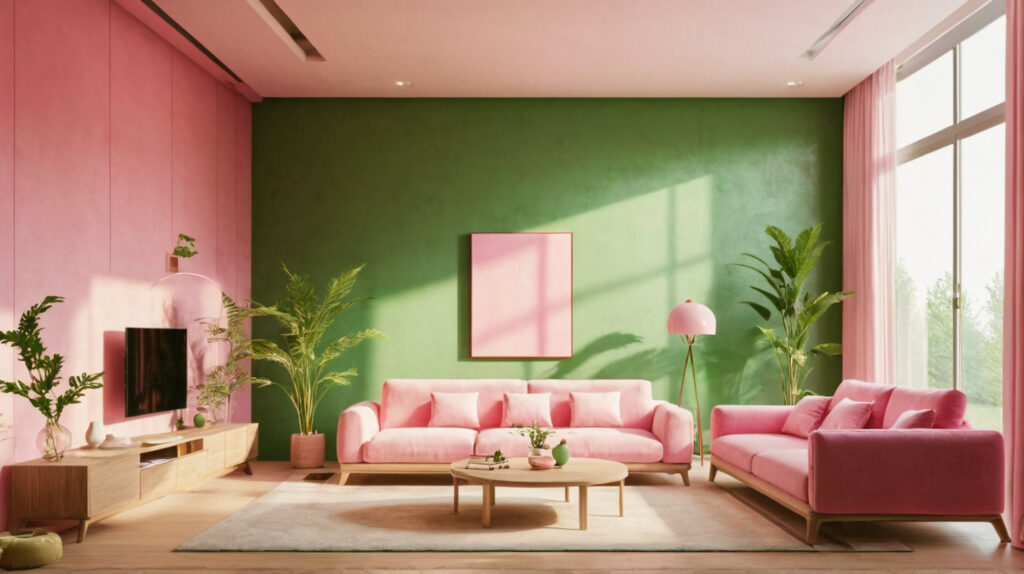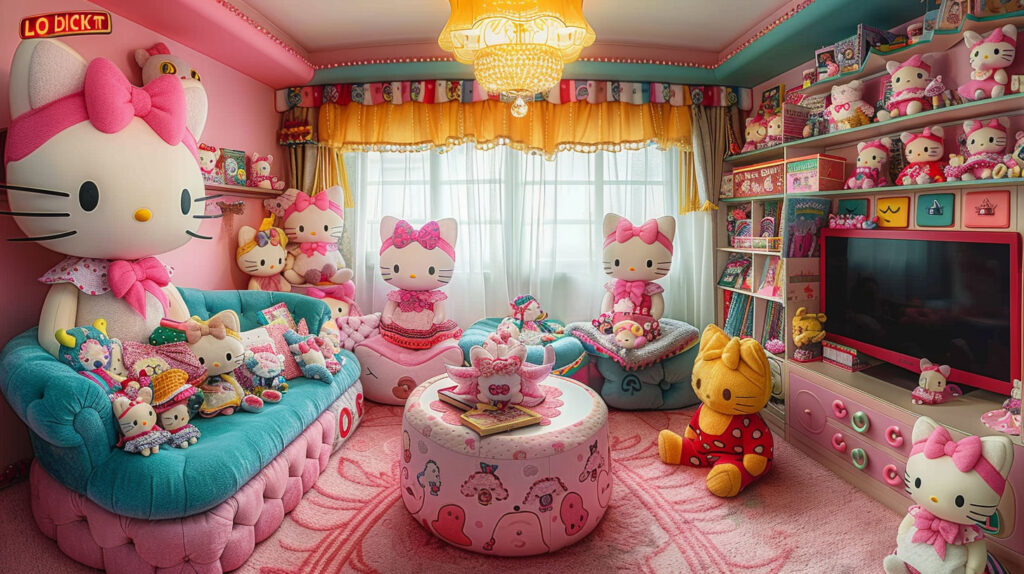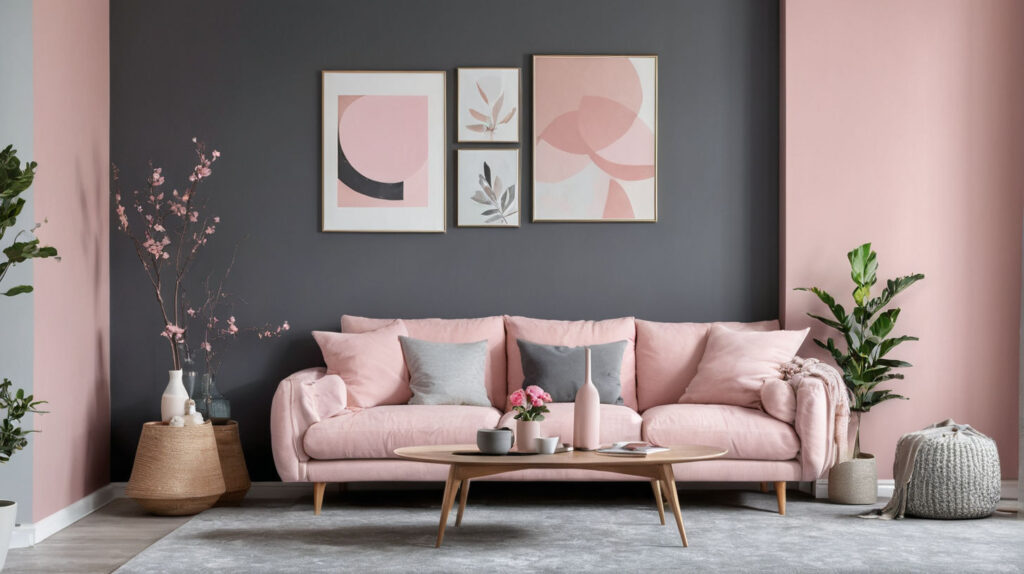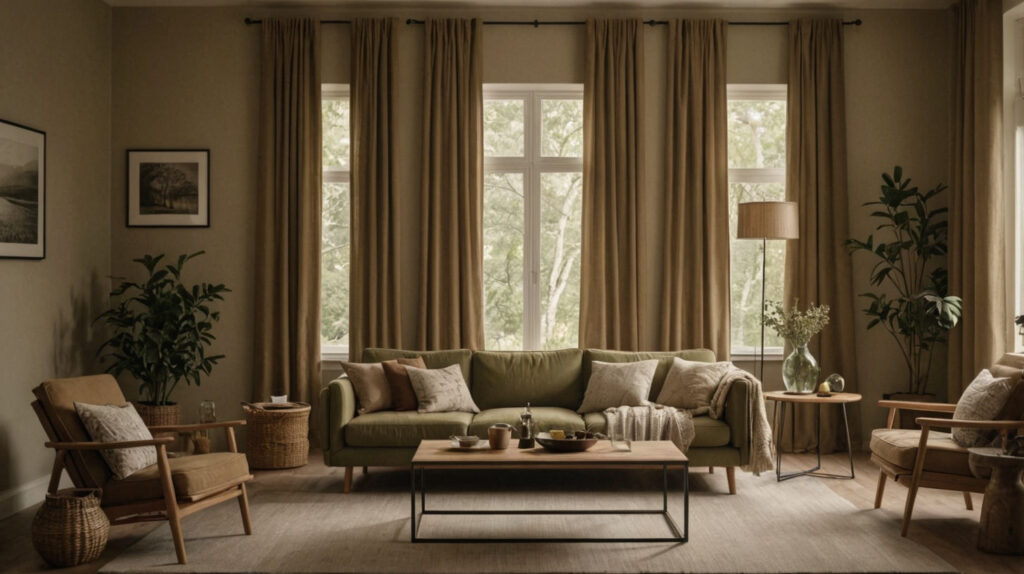Introduction
Creating a pink and blue living room involves mastering the art of color contrast. By understanding the fundamentals of color psychology and design principles, you can achieve a harmonious and visually stunning space. This guide will explore various aspects of designing a living room with these vibrant hues, from choosing the right shades to balancing furniture and accessories.

This vibrant living room showcases a bold and playful color scheme dominated by pink and blue hues. The walls are painted a cheerful pink, creating a warm and inviting atmosphere. A striking blue sofa serves as the centerpiece, adorned with pink patterned throw pillows that tie the room’s color palette together.
The space features an eclectic mix of furniture, including pink armchairs, a blue accent chair, and various wooden side tables. A large rectangular ottoman upholstered in a blue patterned fabric doubles as a coffee table, adding both function and style.
Artwork plays a significant role in the room’s decor, with several framed pieces adorning the pink walls. The largest painting, positioned centrally above the sofa, depicts a beach scene with tropical vegetation, complementing the room’s lively color scheme.
Natural light floods the room through large windows and French doors, enhancing the airy feel. Potted plants scattered throughout bring a touch of nature indoors and add to the tropical vibe.
Textural elements are incorporated through a plush pink area rug, woven cane cabinets, and various decorative objects. Table lamps with white shades provide soft lighting options.
The overall design aesthetic blends mid-century modern influences with coastal and bohemian elements. The result is a bright, cheerful space that exudes energy and personality. Despite the bold color choices, the room maintains a sense of balance and harmony through the thoughtful arrangement of furniture and accessories.
Key Takeaways
- Combining pink and blue can create a striking yet harmonious living room.
- Understanding color psychology helps in achieving the desired ambiance.
- Balance and proportion are key in designing with contrasting colors.
- Incorporating textures and patterns enhances the overall aesthetic.
- Accessorizing strategically brings out the best in the color scheme.
Part 1: Understanding Color Psychology
1. The Impact of Pink in Interior Design

This image showcases a stunning Moroccan-inspired living room with a vibrant pink and blue color scheme. The space is characterized by its distinctive architectural elements, including arched doorways and a striking blue ceiling with intricate border details.
The focal point of the room is a large, plush pink sectional sofa adorned with an array of colorful throw pillows in shades of pink, blue, and patterned designs. The sofa is complemented by pink velvet poufs, adding extra seating and enhancing the luxurious feel of the space.
A ornate brass pendant light hangs from the ceiling, casting intricate shadows and adding a touch of glamour. The walls are painted in a soft pink, creating a warm backdrop for the room’s decor. Various Moroccan-inspired accessories, such as a golden mirror, wall sconces, and decorative objects, adorn the walls and surfaces.
The floor is covered with a large area rug featuring a pink and blue floral pattern that ties the room’s color scheme together. Potted plants, including palm-like specimens, are strategically placed around the room, bringing a touch of nature indoors and emphasizing the exotic ambiance.
Large arched windows and doorways allow ample natural light to flood the space, offering glimpses of palm trees outside and reinforcing the Mediterranean or North African aesthetic. The overall effect is a bold, luxurious, and exotic living area that seamlessly blends traditional Moroccan design elements with contemporary comfort and style.
Pink, often associated with femininity and softness, can have a powerful impact on interior design. The key lies in understanding its various shades and their effects:
- Calming shades: Soft, muted pinks like blush or pale rose create a soothing atmosphere, perfect for relaxation.
- Vibrant shades: Bold pinks such as fuchsia or hot pink inject energy and excitement into a space.
| Shade of Pink | Effect |
|---|---|
| Soft Pink (e.g., Blush) | Creates a calming and soothing atmosphere |
| Bright Pink (e.g., Fuchsia) | Adds energy and excitement to the space |
| Dusty Pink | Evokes a vintage or romantic feel |
| Coral Pink | Brings warmth and a touch of the tropical |
Psychologically, pink is known to:
- Reduce aggression and promote tranquility
- Evoke feelings of compassion and nurturing
- Create a sense of warmth and comfort
When used in a living room, pink can foster a welcoming environment that encourages conversation and relaxation.
Pink can have a powerful impact on interior design. Explore different shades of pink and their effects below:
💡 Designer Tip:
Start with a pale pink as a base color for walls, then add pops of brighter pink in accessories for a balanced look.
2. The Power of Blue in Home Decor

This image showcases an elegant, French-inspired living room with a predominantly pink and blue color scheme. The walls are painted a soft pink, creating a warm and inviting atmosphere.
The room features two pink upholstered sofas in a classic French style, adorned with blue and pink patterned throw pillows. Between them sits a wooden coffee table atop a striking blue area rug, which provides a bold contrast to the pink walls and furniture.
Several blue upholstered armchairs with the same patterned fabric as the throw pillows are arranged around the room, adding to the cohesive color scheme. A white ornate sideboard stands against the back wall, displaying blue and white porcelain pieces.
The room is illuminated by a grand crystal chandelier hanging from the center of the ceiling, adding a touch of luxury and sparkle. Large arched windows and French doors allow ample natural light to flood the space, enhancing its airy feel.
Artwork in gilded frames adorns the walls, including portraits and landscapes that complement the room’s classic aesthetic. Potted plants and fresh flowers add natural elements and vitality to the space.
The flooring appears to be large stone tiles, lending a rustic touch to the otherwise refined decor. Overall, the room exudes a sense of timeless elegance, blending French provincial style with a fresh, feminine color palette.
Blue, a color often associated with the sky and sea, brings a sense of calm and depth to home decor. Its versatility makes it a popular choice for living rooms:
- Light blues: Create an airy, expansive feel, making rooms appear larger.
- Deep blues: Add sophistication and drama, perfect for accent walls or statement pieces.
The emotional impact of blue includes:
- Promoting relaxation and lowering blood pressure
- Enhancing focus and productivity
- Creating a sense of trust and stability
In terms of space perception, blue can:
- Make rooms feel cooler and more spacious
- Create an illusion of depth, especially in darker shades
Blue brings various effects to home decor, depending on its shade:
| Shade of Blue | Effect | Best Used In |
|---|---|---|
| Light Blue | Creates an airy, expansive feel | Bedrooms, bathrooms |
| Navy Blue | Adds sophistication and drama | Living rooms, studies |
| Turquoise | Brings a fresh, energetic vibe | Kitchens, sunrooms |
| Powder Blue | Promotes relaxation and calmness | Nurseries, meditation spaces |
💡 Designer Tip:
Use lighter blues on the ceiling to create the illusion of height, and darker blues on an accent wall for depth.
3. The Harmony of Pink and Blue

This image showcases a vibrant and eclectic living room that harmoniously blends pink and blue hues in a tropical-inspired design. The walls are painted a soft pink, complemented by matching pink curtains that frame the windows. A striking blue accent wall adds depth and contrast to the space.
The furniture arrangement features light blue sofas with rattan or bamboo frames, adorned with an array of pink and floral patterned throw pillows. A pink armchair completes the seating area. The wooden coffee table and side tables introduce natural elements and warmth to the room.
A large circular mirror with a woven rattan frame serves as a focal point, displaying a painting of a coastal scene that reinforces the tropical theme. Blue and white ceramic table lamps and vases are strategically placed throughout, adding visual interest and tying into the color scheme.
The room is further adorned with potted plants and fresh flowers, bringing life and a touch of nature indoors. Framed botanical prints on the walls complement the floral motifs in the textiles.
The overall aesthetic is bright, cheerful, and inviting, blending coastal and tropical influences with a touch of vintage charm. The combination of pink and blue creates a fresh and feminine atmosphere, while the natural textures and plants add depth and character to the space.
Pink and blue, when combined thoughtfully, create a harmonious and visually appealing living room. This combination works well because:
- They are complementary colors, sitting opposite each other on the color wheel
- The warmth of pink balances the coolness of blue
- Together, they create a dynamic yet soothing atmosphere
Successful pink and blue combinations include:
- Pale pink walls with navy blue furniture
- Dusty blue walls with blush pink accents
- White walls with alternating pink and blue decorative elements
The key to success is finding the right balance and intensity of each color to create a cohesive look.
💡 Designer Tip:
Try the 60-30-10 rule: 60% dominant color (e.g., light blue), 30% secondary color (e.g., pale pink), and 10% accent color (e.g., deep blue or bright pink).
Part 2: Design Principles for a Pink and Blue Living Room
4. Choosing the Right Shades
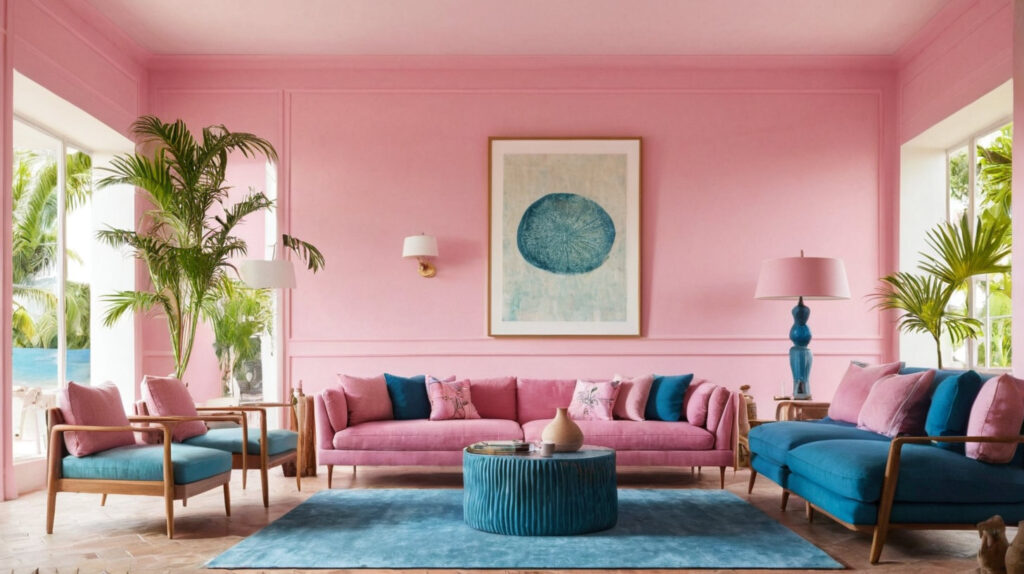
This image showcases a striking living room that beautifully balances pink and blue in a modern tropical setting. The walls are painted a soft pink, creating a warm and inviting atmosphere. The room features a mix of pink and blue furniture, including a long pink sofa as the centerpiece, flanked by blue armchairs with wooden frames.
A circular blue ottoman serves as a coffee table, sitting atop a plush blue area rug that adds texture and defines the seating area. The color scheme is further emphasized through carefully chosen throw pillows in both pink and blue hues.
Large windows on either side of the room bring in abundant natural light and offer views of tropical vegetation outside, reinforcing the room’s connection to nature. Potted palm plants in the corners of the room bring the outdoors inside, adding a fresh, tropical feel.
The focal point of the wall is a large framed artwork featuring a blue circular design, which complements the room’s color palette. A blue table lamp and a wall-mounted sconce provide additional lighting options.
The room’s design aesthetic blends mid-century modern furniture with tropical elements and a contemporary color scheme. The result is a space that feels both sophisticated and relaxed, perfect for a coastal or resort-style home. The harmonious use of pink and blue creates a serene yet vibrant atmosphere, making the room feel both energizing and calming at the same time.
Selecting the perfect shades of pink and blue is crucial for creating a harmonious living room. Consider these factors:
- Room size: Lighter shades for smaller rooms, deeper hues for larger spaces
- Natural light: Cooler blues for south-facing rooms, warmer pinks for north-facing rooms
- Desired mood: Soft pastels for a calm atmosphere, vibrant tones for energy
Tools and tips for color selection:
- Use color wheel apps to find complementary shades
- Collect fabric swatches and paint chips to test combinations
- Consider the room’s existing elements (flooring, architectural features)
💡 Designer Tip:
Test paint colors on large poster boards and move them around the room at different times of day to see how light affects them.
5. Balance and Proportion

This vibrant living room showcases a harmonious blend of pink and blue tones, creating a cheerful and inviting space. The walls are painted a soft, blush pink, providing a warm backdrop for the room’s eclectic decor.
The focal point is a white sofa adorned with an array of cushions in hot pink and light blue, mirroring the room’s color scheme. Flanking the sofa are two pink armchairs, adding symmetry and additional seating. A rectangular coffee table with a wooden top and black metal frame anchors the seating area.
Above the sofa, three framed botanical prints featuring pink flowers and green foliage on blue backgrounds tie the room’s colors together. Two matching blue ceramic table lamps with white shades sit atop woven side tables, contributing to the room’s balanced layout.
Large potted plants with broad green leaves occupy the corners, bringing nature indoors and softening the space. A patterned area rug in shades of blue and pink unifies the seating arrangement and adds visual interest to the hardwood floor.
Accessories like blue vases, pink flowers, and decorative objects on the coffee table enhance the color scheme and add personality to the space. The room’s large windows, partially visible, are dressed with neutral curtains that allow natural light to filter in.
The overall design exudes a tropical, feminine charm with its bold use of color and natural elements. The combination of pink and blue creates a fresh, modern look that’s both playful and sophisticated, perfect for a contemporary living space that doesn’t shy away from vibrant hues.
Achieving the right balance and proportion is key when working with contrasting colors like pink and blue:
- 60-30-10 rule: Use 60% dominant color, 30% secondary color, and 10% accent color
- Visual weight: Balance bold colors with neutral elements
- Color blocking: Use larger blocks of color for a modern look
Guidelines for using contrasting colors:
- Use lighter shades for larger surfaces (walls, floors) and darker shades for smaller areas
- Create focal points with bold color choices
- Use transitional colors (like purple) to bridge the gap between pink and blue
5. Balance and Proportion

The 60-30-10 rule is a classic decor principle that helps create balance in a room:
| Percentage | Use | Example in Pink and Blue Room |
|---|---|---|
| 60% | Dominant color | Light blue walls |
| 30% | Secondary color | Pink furniture or large accessories |
| 10% | Accent color | Deep blue or bright pink decorative items |
💡 Designer Tip:
Create a mood board with fabric swatches, paint chips, and furniture images to visualize the balance before committing to a design.
6. Furniture Selection

Choosing furniture that complements your pink and blue color scheme is crucial for a cohesive look:
- Upholstery: Consider pink or blue fabric for statement pieces
- Wood tones: Light woods for a fresh look, dark woods for sophistication
- Metal accents: Gold for warmth, silver for coolness
Balancing color with neutral furniture:
- Use white or gray furniture to break up bold colors
- Incorporate natural materials like rattan or jute for texture
- Choose clear acrylic pieces for a modern touch without adding visual weight
💡 Designer Tip:
If you’re hesitant about colorful furniture, start with neutral pieces and add pink and blue through easily changeable elements like throw pillows or slipcovers.
7. Incorporating Textures and Patterns
Adding depth to your pink and blue living room through textures and patterns creates a rich, layered look:
- Textures: Velvet, linen, wool, and silk add tactile interest
- Patterns: Geometric, floral, or abstract designs in pink and blue hues
- Layering: Combine different textures and patterns for depth
Role of patterned textiles:
- Use patterned curtains or rugs as a starting point for the room’s color scheme
- Mix small-scale and large-scale patterns for visual interest
- Incorporate patterns through wallpaper, throw pillows, or artwork
💡 Designer Tip:
When mixing patterns, stick to a consistent color palette and vary the scale of the patterns to avoid visual chaos.
Part 3: Accessorizing and Finishing Touches
8. Accessorizing with Pink and Blue
The right accessories can elevate your pink and blue living room from good to great:
- Throw pillows: Mix and match pink and blue in various shades and patterns
- Artwork: Choose pieces that incorporate both colors
- Decorative objects: Vases, sculptures, or books in complementary hues
Tips for selecting accessories:
- Use metallic accents (gold, silver, copper) to add sparkle and contrast
- Incorporate natural elements like plants or flowers for a fresh touch
- Choose a statement piece, like a large mirror or unique light fixture, to anchor the room
💡 Designer Tip:
Create a cohesive look by repeating colors and patterns in at least three places throughout the room.
9. Lighting and Ambiance

Proper lighting can dramatically affect how pink and blue appear in your living room:
- Natural light: Use sheer curtains to maximize daylight
- Ambient lighting: Choose warm-toned bulbs to enhance pink hues
- Accent lighting: Use spotlights or table lamps to highlight specific areas
How lighting affects color perception:
- Cool LED lights can make blues appear more vibrant
- Warm incandescent bulbs can soften pink tones
- Dimmer switches allow for adjustable ambiance throughout the day
💡 Designer Tip:
Layer different types of lighting (overhead, task, and accent) to create a versatile and inviting atmosphere.
10. Bringing It All Together
Follow this step-by-step guide to assemble your pink and blue living room:
- Paint walls and ceiling (if desired)
- Install any wallpaper or large wall art
- Place large furniture pieces
- Add area rugs and window treatments
- Incorporate smaller furniture and storage solutions
- Arrange lighting fixtures
- Add decorative accessories and art
- Style surfaces (coffee tables, shelves) with books and objects
Final touches for a cohesive look:
- Ensure a balance of pink and blue throughout the space
- Add plants or fresh flowers for a natural element
- Step back and assess the overall feel, making adjustments as needed
💡 Designer Tip:
Take photos of your room from different angles to get a fresh perspective and identify areas that need tweaking.
FAQs
What are the best shades of pink and blue for a living room?
The best shades depend on your personal style and the room’s characteristics. For a calming atmosphere, consider pale pink (like blush or rose quartz) paired with light blue (such as sky blue or powder blue). For a more dramatic look, try deep pink (fuchsia or magenta) with navy or royal blue. Always consider the room’s size and natural light when choosing shades. Lighter hues can make a small room feel larger, while darker shades add coziness to larger spaces.
How do I balance pink and blue with other colors?
To balance pink and blue with other colors:
- Use neutrals: White, gray, or beige can soften the contrast between pink and blue
- Add metallics: Gold, silver, or copper accents can complement both colors
- Incorporate natural elements: Wood tones and greenery can add warmth and balance
- Consider a third color: A touch of yellow or green can create a harmonious triad
Remember to use the 60-30-10 rule: 60% dominant color, 30% secondary color, and 10% accent color for a well-balanced look.
Can I use pink and blue in a small living room?
Yes, you can use pink and blue in a small living room effectively with these space-saving design tips:
- Use lighter shades of pink and blue to create an airy, open feel
- Paint one accent wall in a deeper shade for depth without overwhelming the space
- Incorporate pink and blue through accessories rather than large furniture pieces
- Use mirrors to reflect light and create the illusion of more space
- Choose furniture with clean lines and raised legs to maintain visual openness
- Opt for multi-functional pieces to maximize floor space
Remember, in a small space, less is often more. Be selective with your pink and blue elements to avoid cluttering the room.
Conclusion
Creating a pink and blue living room is an exciting way to master the art of color contrast. By understanding color psychology, applying design principles, and carefully selecting shades, furniture, and accessories, you can craft a space that is both visually stunning and harmonious. Remember to balance bold choices with neutral elements, incorporate various textures and patterns, and pay attention to lighting to bring out the best in your color scheme. With these tips and techniques, you’ll be well-equipped to design a pink and blue living room that reflects your personal style and creates a welcoming atmosphere for all who enter.










